Trains, and
Boats and Trams
A Grand
Excursion into the Canadian Rockies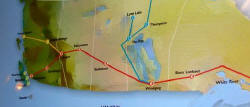
By Pat
and Rich Middleton
©
Photos and text may not be reproduced in any format without
the express permission of Great River Publishing.
I think it has been 35
years since we have anticipated a travel
adventure as much as this. Yes, we’ve cruised China's Yangtze River, and that was
fascinating. We spent two weeks on the Amazon, and that
was fascinating. We’ve criss-crossed the American National
Parks in tent, lodge and motor home, immersing ourselves in one
amazing biome of natural beauty after another. Rich had even
“done” Canada’s Rocky Mountains 40 years ago with his Dad and uncle as they
bumped across the unpaved Alcan Highway to Alaska.
This
“grand excursion” into the Canadian Rockies promised storied
destinations and traditions well beyond the usual interest of
a “trip.” We would travel on trains and trams and excursion
boats through choking wilderness, stumble over bone-chilling
mountain glaciers, and hike to pristine alpine lakes. Rich had
anticipated revisiting the Canadian Rockies ever since his non-stop
road-trip to Alaska.

“Pat, the sharp-edged mountains are so abrupt, with snowcaps,
and emerald lakes… I promise you that Jasper, Lake Louise and
Banff… are the most beautiful places on earth,” he
enthused. At least that’s how he remembered them 40 years later.
Trains and Boats and
Trams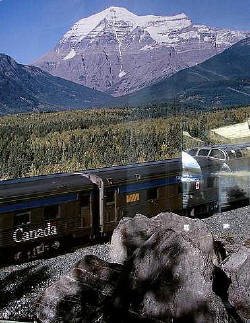
We were not
entirely unfamiliar with the modes of travel that we would
encounter on our trip to the Canadian Rockies. Our first
extensive train travel had been with a 2nd class
Euro-rail Pass for 6 weeks in Europe. Then, a pup tent
was our only
hotel. A 60-pound backpack our only luggage.
A cruise on the castle-studded
Rhine River was included with our rail pass. And here and
there in the Swiss Alps, there were trams that swept us up the mountain sides for a view of the vast horizons. Our only guide
and itinerary on that first grand tour of Europe was drawn
from Arthur Frommer’s
Europe on $5 a Day. (Now that does date us!)
But what a difference 35 years makes!


Our passage on this VIA RAIL journey read
FIRST CLASS, and included snacks and entertaining live music
as we waited for the train to arrive at the station. The
musician, reminiscent of the Riverlorian on a
steamboat, also provided a preview of what we could expect on
our journey.
,

We left Central Station in
Vancouver, British Columbia on VIA RAILs Canadian at 5 p.m.
sharp, to commence a journey on the silver tracks through a
boundless wilderness of trees and waterways and mountain peaks that would deposit
us at the Jasper train station at about 11 a.m. the next day.
After a modest Welcome Aboard
party in the observation car, we
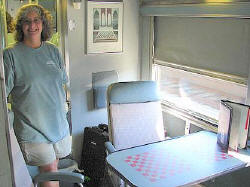 savored
our first moments of settling into our double suite. By day
there was a window table and comfortable chairs. The trains
had been put into service in the 1950s and had been
refurbished to reflect that 1950s decor. A sink and toilet on
either side hinted at the relative luxury in which we
traveled.
savored
our first moments of settling into our double suite. By day
there was a window table and comfortable chairs. The trains
had been put into service in the 1950s and had been
refurbished to reflect that 1950s decor. A sink and toilet on
either side hinted at the relative luxury in which we
traveled.
When we returned from a fine
railway dinner of salmon and steak, wine and chocolate torte, the
room had been transformed to a comfortable bedroom by our
attentive French Canadian steward.
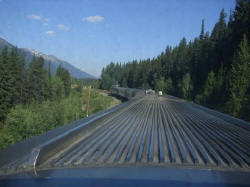
Our
VIA RAIL
trip promised a first view of what I had really longed to see
in Canada, wilderness.
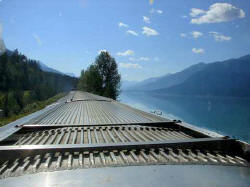
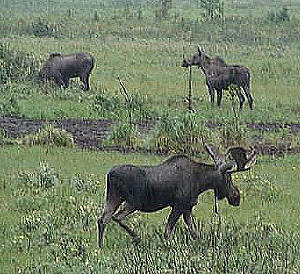
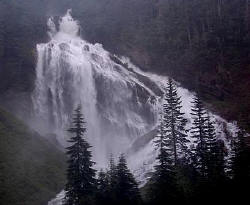
The
mountains this time would not be the Swiss Alps, but the
ragged, uplifted “front ranges” of the Canadian Rockies.
Our route would follow the Fraser River through the rich
farmland of its flood plains, and through vast logging
operations and almost to the foot of Mt. Robson, before
veering off to follow the Thompson River. Forests logged
inland are comprised of Lodgepole pine, White Spruce, a few
Douglas Fir, and Aspen.
 About 8 p.m. we had a clear
overhead view of Hell's Gate from the domed observation
car. Here the broad and placid Fraser River is transformed
into a roaring maelstrom of churning white water as it is
forced through a narrow gorge. Trams near Jasper, Lake Louise
and Banff would sweep us up high above the twisting Athabasca
River, and myriad glacier-fed lakes.
About 8 p.m. we had a clear
overhead view of Hell's Gate from the domed observation
car. Here the broad and placid Fraser River is transformed
into a roaring maelstrom of churning white water as it is
forced through a narrow gorge. Trams near Jasper, Lake Louise
and Banff would sweep us up high above the twisting Athabasca
River, and myriad glacier-fed lakes.
TRAINS,
Silver Rails to Canada’s West Coast.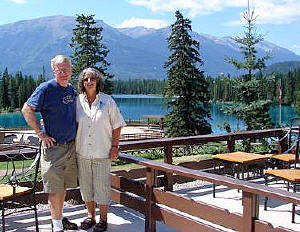
There is a long history of
collaboration that ties Canada’s railway system to historic
luxury hotels in the Canadian National Parks. Canada’s
commitment to tie the West Coast with Ottawa was established
in 1871 in an effort to lure British Columbia into joining the
new Canadian confederation.
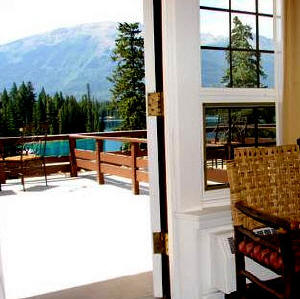
Canada was eager to meet the BC
demand for a trans-Canada railway, but it was far more challenging than could be imagined
in government halls in Ottawa. And once built, the Canadian
Pacific Railway would need to be self-financing. An
American railway executive was brought in to finish the
project, … Wm. C. Van Horne... who took on the challenge of building
and then paying for the trans-Canada railway. The construction
was completed in 1881.
There was no question in Van
Horne’s mind about where the financial potential for the new
railroad lay. For many
of the wealthy, the Grand Tour of Europe… the Alps, the
cathedrals, the great cities… was already checked off. They
had, “Been
there, done that.”
What lay beyond the prairies of
Central Canada, however, was uncharted wilderness, undiscovered
mountains, a
vast private playground reachable only by wealthy train
travelers.
“If we can’t export the
scenery,” Van Horne vowed, “we’ll import the tourists.”


Van Horne, already General
Manager of the Canadian Pacific Railway now founded the
Canadian Pacific Hotels. The railroad hotels would
provide accommodations and comfort for tourists brought in by
the railway. Van Horne provided free transportation and
lodging to writers and artists to help the railway describe
the wonder of the Canadian Rockies and the waters flowing
through and out of the pristine glacial snow-capped
mountains….
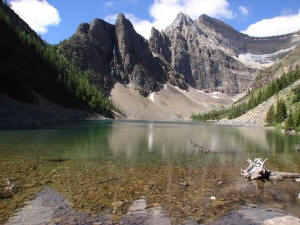
“You shall see mighty rivers,
vast forests, boundless plains, stupendous mountains, and
wonders innumerable….” declared the authors, "and you shall see it all in comfort,
nay in luxury.”
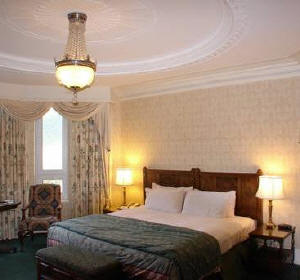
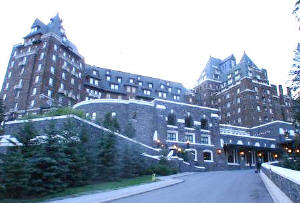
The historic luxury
hotels in Jasper, Banff, and Lake Louise all grew out of this
grand plan to connect Canada from sea to sea by rail and at
the same time open up the Canadian Rockies to the world’s
wealthiest tourists.
The Via Rail we traveled today is
the passenger arm of the old Canadian Pacific Railway.
The first Canadian national park was Banff
National Park, centered around the thermal springs discovered
by two railroad workers near the town of Banff. The Upper Hot
Springs in Banff is still open to the public.
As national parks were developed
to provide amenities and access for the wealthy, towns sprang
up near the hotels. Once again, the railway and the park
system developed a joint oversight arrangement. To this day,
the National Parks have significant overview privileges as
towns develop. As recently as 15 years ago, Banff was
completely governed by the park system. One significant
aspect, for example, has to do with a residency requirement
for Banff, Lake Louise and Jasper. Only people who live and
work in the area can purchase homes there.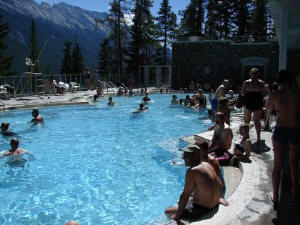
Eventually Jasper and YoHo
National Parks, along with Banff were declared a UNESCO
World Heritage Site, which affirms and protects the
Canadian Rocky Mountains as an area of
international cultural significance.
“Seas
of people, islands of wilderness…”
The
management philosophy of the national parks in Canada h as
evolved somewhat from the turn of the 20th century,
when the first national parks were thought of as small islands
of humanity in a “sea of wilderness .”
as
evolved somewhat from the turn of the 20th century,
when the first national parks were thought of as small islands
of humanity in a “sea of wilderness .”
The first
park was developed to protect the valuable thermal springs at
what would soon become Banff, and to cooperate with the
railway in luring to the mountains wealthy people who could
then help develop the area.
Then
evolved the policy that the parks belonged to the people and
the system would help make the wilderness accessible to common
travelers who were taking to the roads en masse with the
introduction of the automobile. In the 1980s, as people began
to crowd the native animals from their home ranges, a movement
began to emphasize protecting both people and wilderness.
Today the
emphasis is on protecting the wildlife, plants, all the
wilderness area from an endless sea of visitors and
development.
The Banff Park Museum at the bridge in Banff is interesting as
a relic of the old park philosophy. It is Canada’s oldest
natural history museum. While exhibits in the old museum are
labeled, there is little interpretive information in the
museum. To best appreciate the exhibits, try to join a tour or
find a docent to show you around.
To follow our itinerary
through the Columbian Icefields, and our visits to Jasper,
Lake Louise and Banff, please CLICK HERE.
IF YOU GO......

Visit the VIARAIL
website at
http://www.viarail.ca/en_index.html
Also....
Trip planning in the
Canadian National Parks
www.Parkscanada.pch.gc.ca
or 888-773-8888
Fairmont Hotels and Resorts
www.fairmont.com
Return to:
More Classic Train
Journeys:
Alaska Rail
Waterway Cruises Directory for more great travel reports.
www.greatriver.com The Mississippi River Home Page
 Greatriver.com is
now visited by well over 35,000 unique households each month!
Greatriver.com is
now visited by well over 35,000 unique households each month!
We are rated #1 by Google for Mississippi River Travel,
Great River Road, and many, many other related Mississippi River topics!!!!!
There is NO better venue to advertise YOUR river-related visitor service!!
[
Return to
Mississippi River Home Page ]
Website Design by Great
River Publishing
Rt. 1, Stoddard, WI 54658-9801
Phone 608-457-2734 or email mail@greatriver.com
for complete information.
Photos and Content may not be used in any format without the express
permission of Greatriver Publishing.